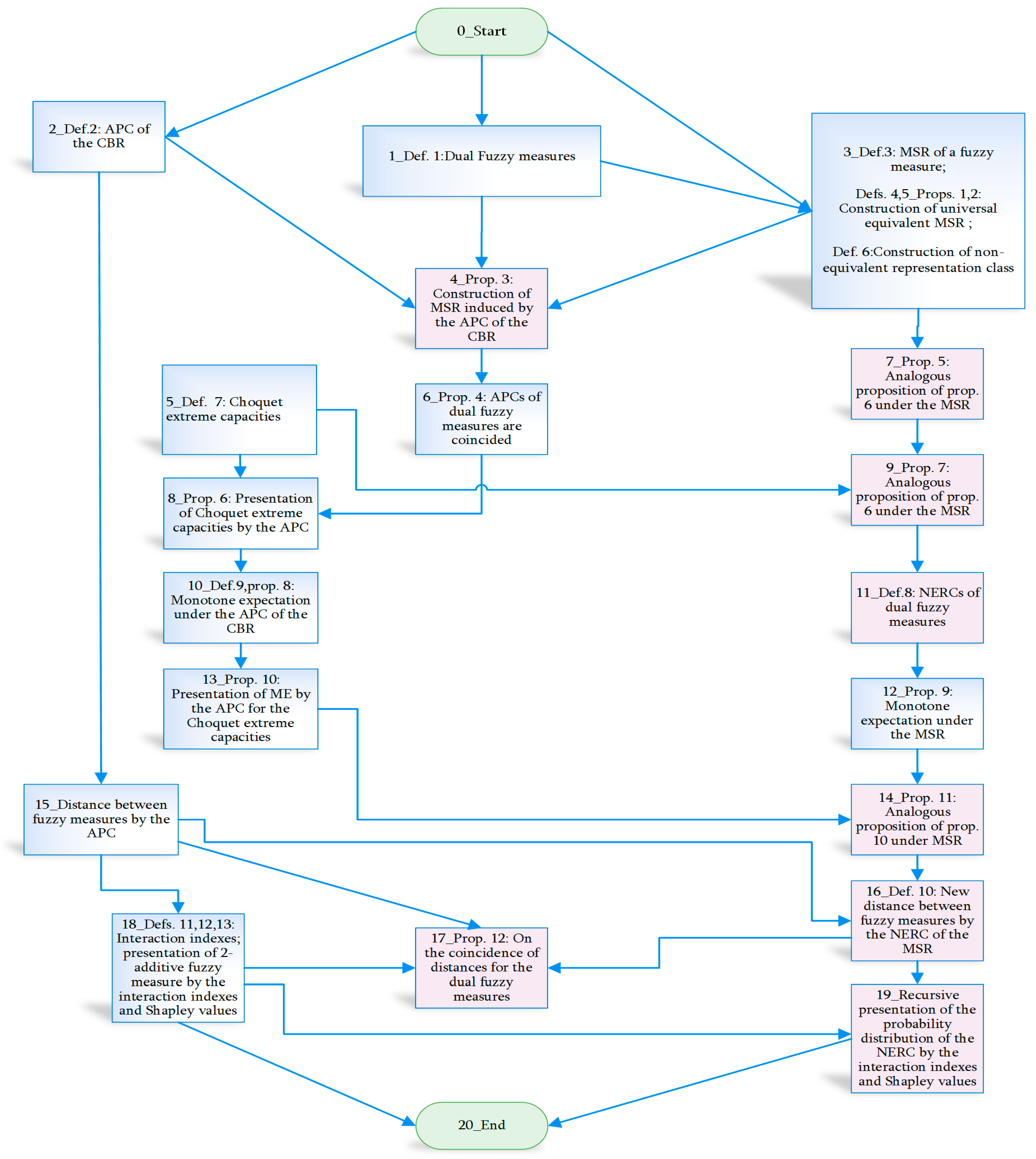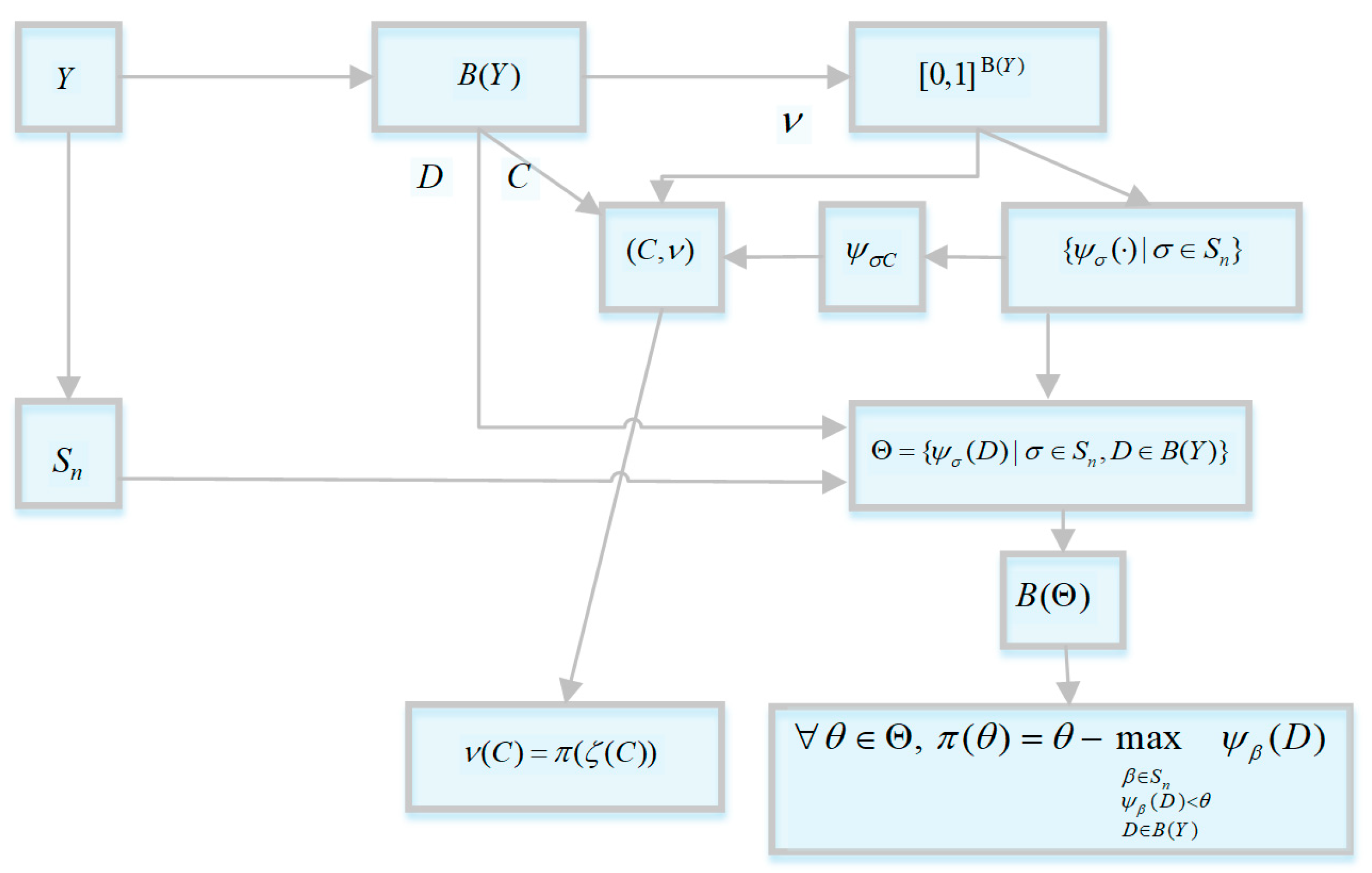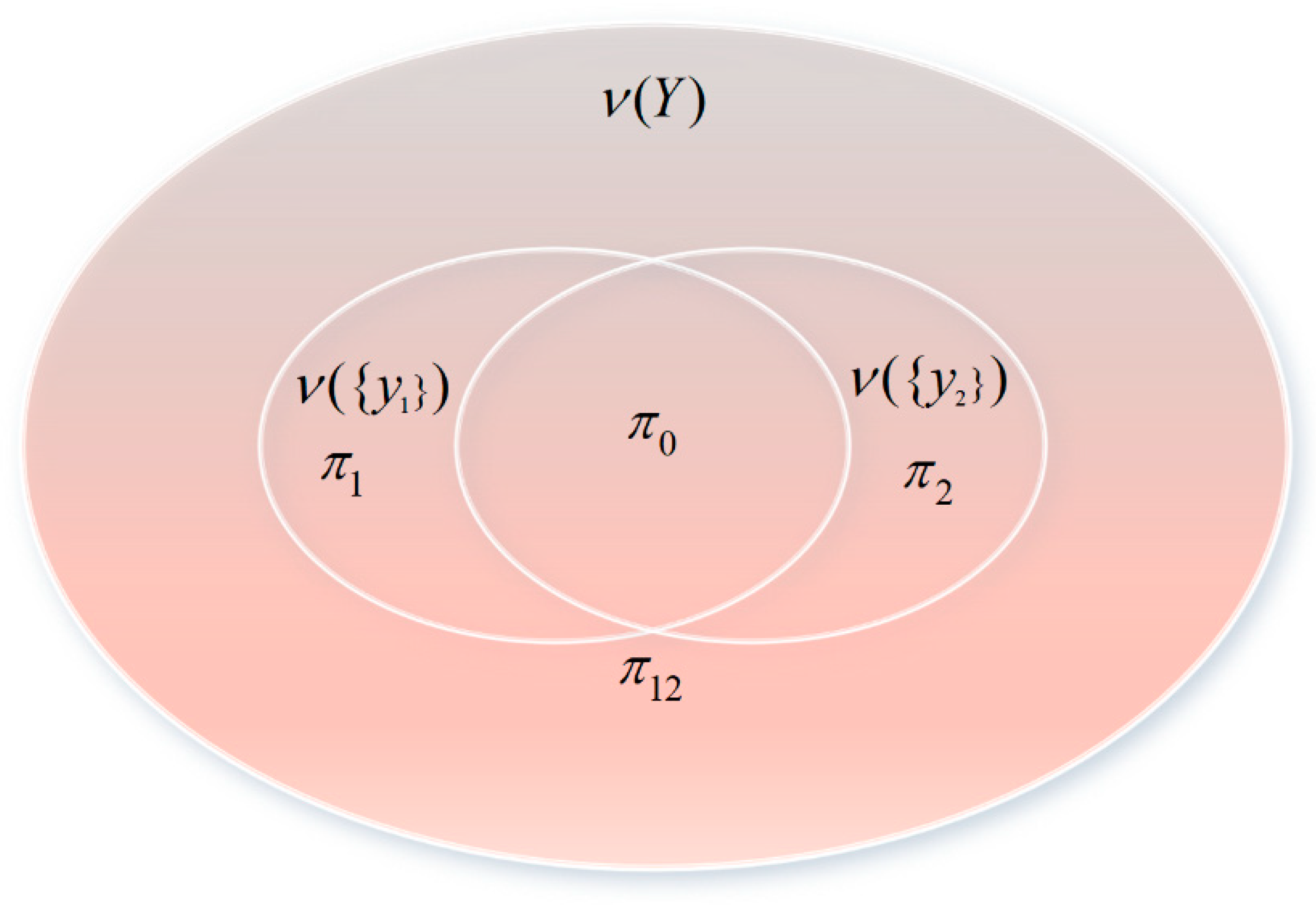Connections between Campos-Bolanos and Murofushi–Sugeno Representations of a Fuzzy Measure
Abstract
:1. Introduction
- when groups and work disjointedly;
- when the groups work together and their collaboration is effective;
- when the groups work together and their collaboration is ineffective.
2. Preliminary Concepts
3. Connection between Campos-Bolanos and Murofushi–Sugeno Representations
4. Choquet’s Capacities of Order Two in Murofushi–Sugeno Representations
5. Distance on Fuzzy Measures’ Space in MSR
6. Connections between Two-Order Additive Fuzzy Measure and Interaction Indexes of Attributes in the MSR Environment
7. An Illustrative Example
8. Conclusions
Author Contributions
Funding
Institutional Review Board Statement
Informed Consent Statement
Data Availability Statement
Conflicts of Interest
List of Symbols
| Y | finite set (universum) |
| elements of Y | |
| set of all subsets of Y | |
| fuzzy measure on | |
| dual fuzzy measure to | |
| fuzzy measure space | |
| A, B, C, D, G | subsets of Y |
| complement of | |
| N | natural number |
| permutation group of natural numbers from 1 to n | |
| elements of | |
| dual permutation of | |
| associated probabilities on | |
| associated probability class (APC) of the fuzzy measure | |
| finite set of some definite “indexes” | |
| element of | |
| set of all subsets of | |
| 0–1 order-preserving homomorphism | |
| dual probability measures on | |
| (,,,) | Murofushi–Sugeno representation (MSR) of the fuzzy measure |
| set of all semi-filters in | |
| Se | semi-filter |
| , | 0–1 order-preserving homomorphisms |
| probability measures on () | |
| M | mapping () |
| subset of | |
| mapping: () | |
| (,(),) | equivalent MSR of the fuzzy measure . |
| classes of probability measures of nonequivalent MSRs of dual fuzzy measures and . | |
| (), | nonequivalent representation class of the fuzzy measure . |
| subset of APC | |
| mapping from the composition connection between CBR and MSR | |
| W | fuzzy subset of Y |
| membership function of fuzzy subset W | |
| monotone expectation of with respect to the fuzzy measure | |
| Choquet’s integral on | |
| Lebesgue measure on [0;1] | |
| subset of | |
| mathematical expectation of with respect to the probability measure | |
| indicator of subset | |
| distances between fuzzy measures | |
| concatenation operation of numbers and | |
| linear function | |
| lower and upper limit values | |
| a, | constants |
| Shapley value | |
| Interaction index | |
| Mobius transformation | |
References
- Abdullah, L.; Awang, N.A.; Othman, M. Application of Choquet Integral-Fuzzy Measures for Aggregating Customers’ Satisfaction. Adv. Fuzzy Syst. 2021, 2021, 1–8. [Google Scholar] [CrossRef]
- Ban, A.I.; Gal, S. On the defect of additivity of fuzzy measures. Fuzzy Sets Syst. 2002, 127, 353–362. [Google Scholar] [CrossRef]
- Beliakov, G.; Divakov, D. On representation of fuzzy measures for learning Choquet and Sugeno integrals. Knowl.-Based Syst. 2019, 189, 105134. [Google Scholar] [CrossRef]
- Beliakov, G.; James, S.; Wu, J.-Z. Discrete Fuzzy Measures. Computational Aspect. In Studies in Fuzziness and Soft Computing 382; Springer: Berlin/Heidelberg, Germany, 2020; 255p. [Google Scholar]
- Choquet, G. Theory of capacities. Ann. Inst. Fourier 1953, 5, 131–295. [Google Scholar] [CrossRef] [Green Version]
- Denneberg, D. Non-Additive Measure and Integral; Springer Science & Business Media: Berlin/Heidelberg, Germany, 1994. [Google Scholar] [CrossRef]
- Grabisch., M.; Murofushi, T.; Sugeno, M. Fuzzy measures and integrals: Theory and applications. Stud. Fuzziness Soft Comput. 2000, 40, 1–400. [Google Scholar]
- Murofushi, T.; Sugeno, M. A theory of fuzzy measures: Representations, the Choquet integral, and null sets. J. Math. Anal. Appl. 1991, 159, 532–549. [Google Scholar] [CrossRef] [Green Version]
- Huang, L.; Wu, J.-Z.; Beliakov, G. Multicriteria correlation preference information (MCCPI) with nonadditivity index for decision aiding. J. Intell. Fuzzy Syst. 2020, 39, 3441–3452. [Google Scholar] [CrossRef]
- Huang, L.; Wu, J.-Z.; Xi, R.-J. Nonadditivity Index Based Quasi-Random Generation of Capacities and Its Application in Comprehensive Decision Aiding. Mathematics 2020, 8, 301. [Google Scholar] [CrossRef] [Green Version]
- Wu, J.-Z.; Beliakov, G. Nonadditivity index and capacity identification method in the context of multicriteria decision making. Inf. Sci. 2018, 467, 398–406. [Google Scholar] [CrossRef]
- Wu, J.-Z.; Beliakov, G. Nonadditivity Index Oriented Decision Preference Information Representation and Capacity Identification. Econ. Comput Econ. Cybern Stud. Res. 2020, 54, 281–297. [Google Scholar]
- Grabisch, M. The representation of importance and interaction of features by fuzzy measures. Pattern Recognit. Lett. 1996, 17, 567–575. [Google Scholar] [CrossRef]
- Grabisch, M. Alternative Representations of Discrete Fuzzy Measures for Decision Making. Int. J. Uncertain. Fuzziness Knowl.-Syst. 1997, 5, 587–607. [Google Scholar] [CrossRef]
- Grabisch, M. K-order additive discrete fuzzy measures and their representation. Fuzzy Sets Syst. 1997, 92, 167–189. [Google Scholar] [CrossRef]
- Grabisch, M.; Kojadinovic, I.; Meyer, P. A review of methods for capacity identification in Choquet integral based multi-attribute utility theory. Eur J. Oper Res. 2008, 186, 766–785. [Google Scholar] [CrossRef] [Green Version]
- Campos, L.M.; Bolaños, M.J. Representation of fuzzy measures through probabilities. Fuzzy Set Syst. 1989, 31, 23–26. [Google Scholar]
- De Campos, L.M.; Lamata, M.T.; Moral, S. Distances between fuzzy measures through associated probabilities: Some applications. Fuzzy Sets Syst. 1990, 35, 57–68. [Google Scholar] [CrossRef] [Green Version]
- Murofushi, T.; Sugeno, M. An interpretation of fuzzy measures and the Choquet integral as an integral with respect to a fuzzy measure. Fuzzy Sets Syst. 1989, 29, 201–227. [Google Scholar] [CrossRef]
- Sirbiladze, G. Fuzzy Subset Construction through the Associated Probabilities. Bull. Georgian Natl. Acad. Sci. 2001, 163, 436–440. [Google Scholar]
- Sirbiladze, G.; Zaporozhets, N. About two Probability Representations of Fuzzy Measures on a Finite Set. J. Fuzzy Math. 2003, 1, 549–566. [Google Scholar]
- Sirbiladze, G. Sci New Fuzzy Aggregation Operators Based on the Finite Choquet Integral—Application in the MADM Problem. Int. J. Inf. Technol. Decis. Mak. 2016, 15, 517–551. [Google Scholar] [CrossRef]
- Sirbiladze, G.; Badagadze, O. Intuitionistic Fuzzy Probabilistic Aggregation Operators Based on the Choquet Integral: Application in Multicriteria Decision-Making. Int. J. Inf. Technol. Decis. Mak. 2017, 16, 245–279. [Google Scholar] [CrossRef]
- Sirbiladze, G.; Khutsishvili, I.; Badagadze, O.; Tsulaia, G. Associated probability intuitionistic fuzzy weighted operators in business start-up decision making. Iran. J. Fuzzy Syst. 2018, 15, 1–25. [Google Scholar] [CrossRef]
- Sirbiladze, G.; Khutsishvili, I.; Midodashvili, B. Associated immediate probability intuitionistic fuzzy aggregations in MCDM. Comput. Ind. Eng. 2018, 123, 1–8. [Google Scholar] [CrossRef]
- Sirbiladze, G.; Sikharulidze, A. Extentions of Probability Intuitionistic Fuzzy Aggregation Operators in Fuzzy Environmet. Int J. Inf. Technol. Decis. Mak. 2018, 17, 621–655. [Google Scholar] [CrossRef]
- Sirbiladze, G. Associated Probabilities’ Aggregations in Interactive MADM for q-Rung Orthopair Fuzzy Discrimination Envi-ronment. Int. J. Intell. Syst. 2020, 35, 335–372. [Google Scholar] [CrossRef]
- Sirbiladze, G. Associated Probabilities in Interactive MADM under Discrimination q-Rung Picture Linguistic Environment. Mathematics 2021, 9, 2337. [Google Scholar] [CrossRef]
- Sirbiladze, G.; Garg, H.; Khutsishvili, I.; Ghvaberidze, B.; Midodashvili, B. Associated probabilities aggregations in multistage investment decision-making. Kybernetes 2021. ahead of printing. [Google Scholar] [CrossRef]
- Sirbiladze, G.; Midodashvili, B.; Midodashvili, L.; Siprashvili, D. About One Representation-Interpeter of a Monotone Measure. J. Comput. Cogn. Eng. 2021, 1. [Google Scholar] [CrossRef]
- Sirbiladze, G.; Zaporozhets, N. Choquet’s Capacity of Order Two in the Murofushi-Sugeno’s Probability Representation of a Fuzzy Measure. Bull. Georgian Acad. Sci. 2002, 165, 235–238. [Google Scholar]
- Javier, M.; Guillaume, S.; Pilar, B. k-maxitive fuzzy measures: A scalable approach 2 to model interactions. Fuzzy Sets Syst. 2017, 324, 33–48. [Google Scholar]
- Ünver, M.; Özçelik, G.; Olgun, M. A fuzzy measure theoretical approach for multi criteria decision making problems containing sub-criteria. J. Intell. Fuzzy Syst. 2018, 35, 6461–6468. [Google Scholar] [CrossRef]
- Javier, M.; Serge, G.; Tewfik, S.; Pilar, B. An algorithm for computing the generalized interaction index for k-maxitive fuzzy measures. J. Intell. Fuzzy Syst. 2020, 38, 1–11. [Google Scholar]
- Buck, A.R.; Anderson, D.T.; Keller, J.M.; Wilkin, T.; Islam, M.A. A Weighted Matrix Visualization for Fuzzy Measures and Integrals. In Proceedings of the 2020 IEEE International Conference on Fuzzy Systems (FUZZ-IEEE), Glasgow, UK, 19–24 July 2020; pp. 1–8. [Google Scholar] [CrossRef]
- Zhang, M.; Cao, C. A 2-order Additive Fuzzy Measure Identification Method Based on Hesitant Fuzzy Linguistic Interaction Degree and Its Application in Credit Assessment. J. Intell. Fuzzy Syst. 2021. [CrossRef]
- Sugeno, M. Theory of Fuzzy Integrals and Its Applications. Ph.D. Thesis, Tokyo Institute of Technology, Tokyo, Japan, 1974. [Google Scholar]





Publisher’s Note: MDPI stays neutral with regard to jurisdictional claims in published maps and institutional affiliations. |
© 2022 by the authors. Licensee MDPI, Basel, Switzerland. This article is an open access article distributed under the terms and conditions of the Creative Commons Attribution (CC BY) license (https://creativecommons.org/licenses/by/4.0/).
Share and Cite
Sirbiladze, G.; Manjafarashvili, T. Connections between Campos-Bolanos and Murofushi–Sugeno Representations of a Fuzzy Measure. Mathematics 2022, 10, 516. https://doi.org/10.3390/math10030516
Sirbiladze G, Manjafarashvili T. Connections between Campos-Bolanos and Murofushi–Sugeno Representations of a Fuzzy Measure. Mathematics. 2022; 10(3):516. https://doi.org/10.3390/math10030516
Chicago/Turabian StyleSirbiladze, Gia, and Teimuraz Manjafarashvili. 2022. "Connections between Campos-Bolanos and Murofushi–Sugeno Representations of a Fuzzy Measure" Mathematics 10, no. 3: 516. https://doi.org/10.3390/math10030516
APA StyleSirbiladze, G., & Manjafarashvili, T. (2022). Connections between Campos-Bolanos and Murofushi–Sugeno Representations of a Fuzzy Measure. Mathematics, 10(3), 516. https://doi.org/10.3390/math10030516






